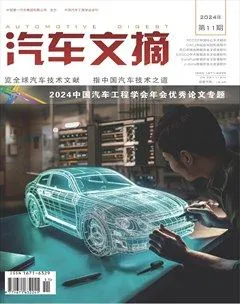整车声学统计能量分析定制优化
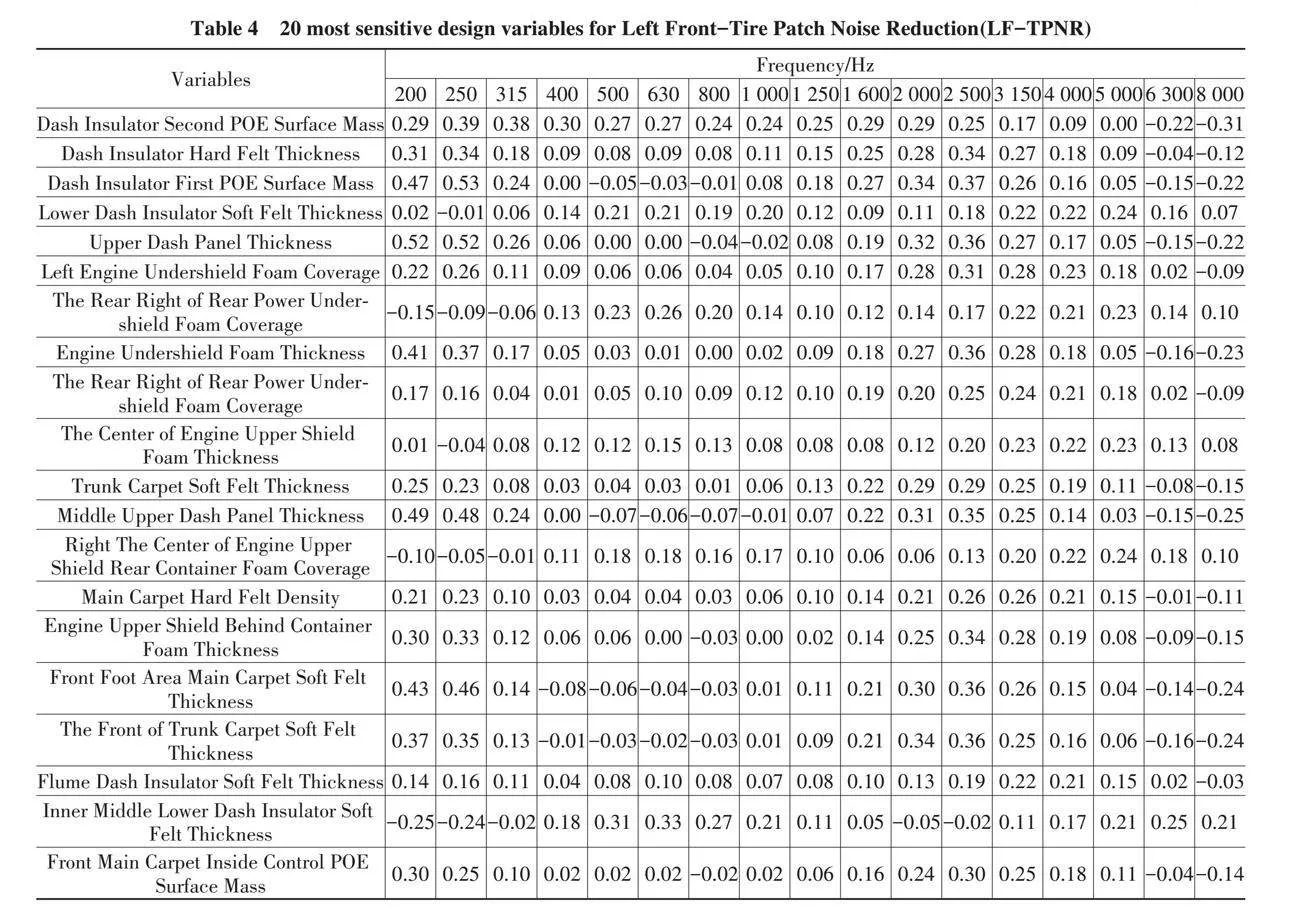
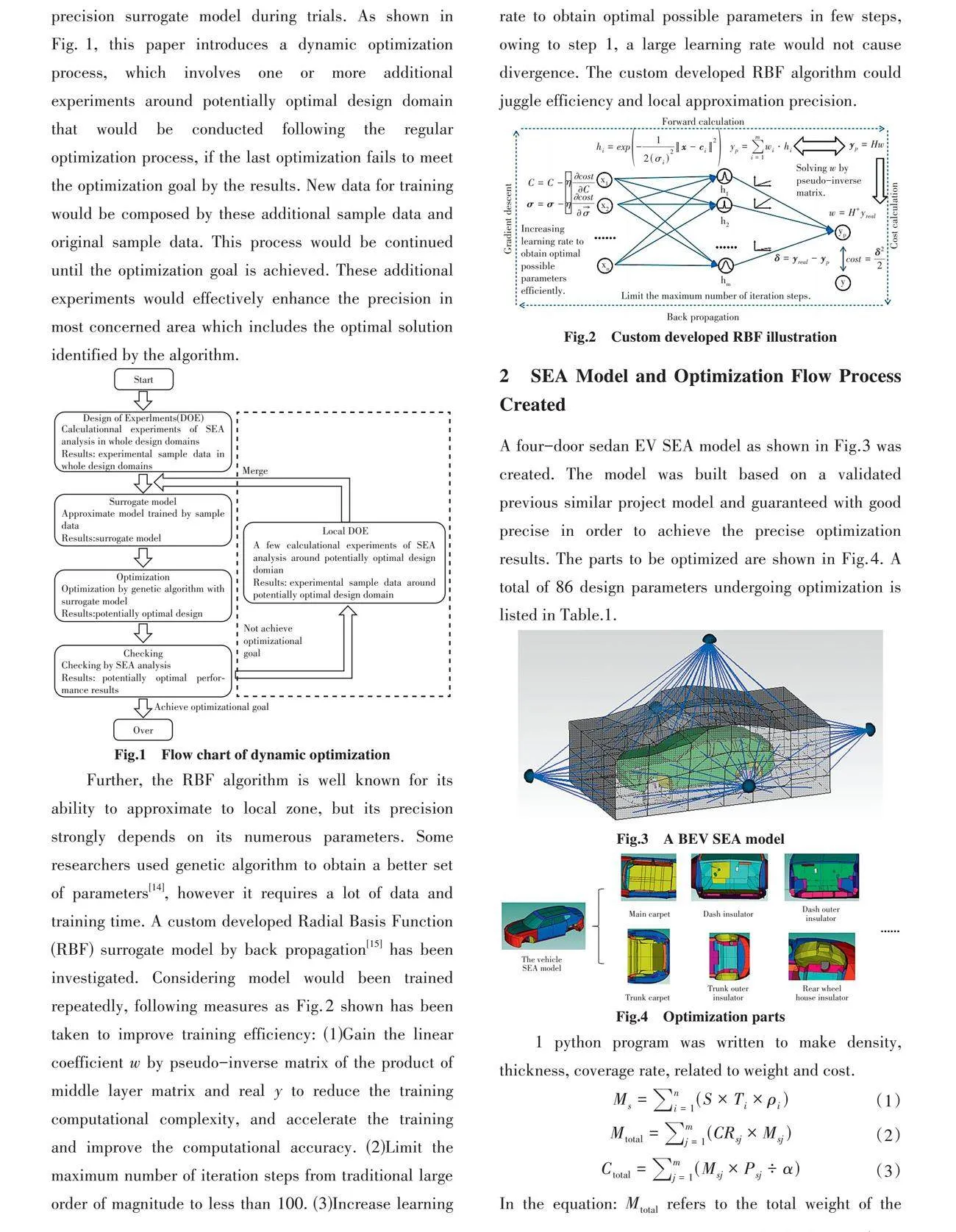

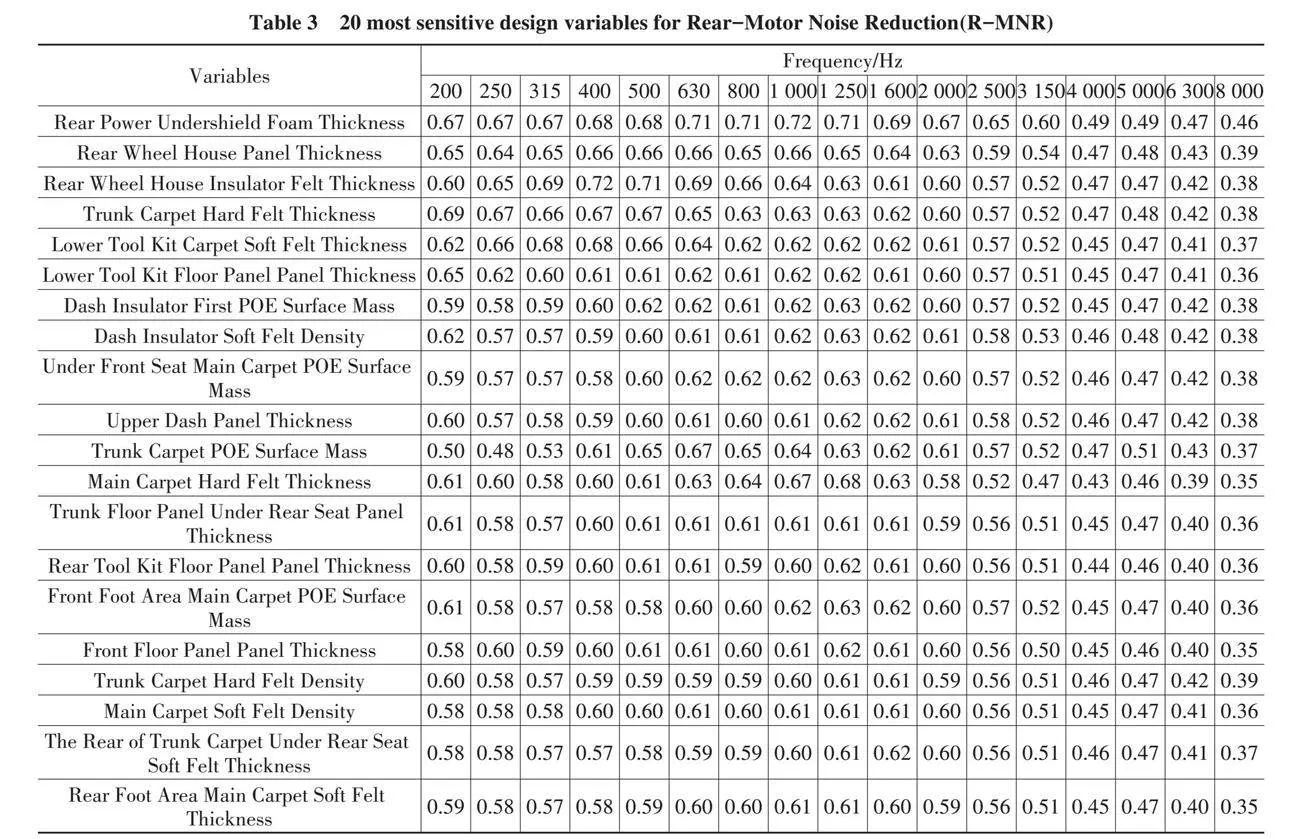
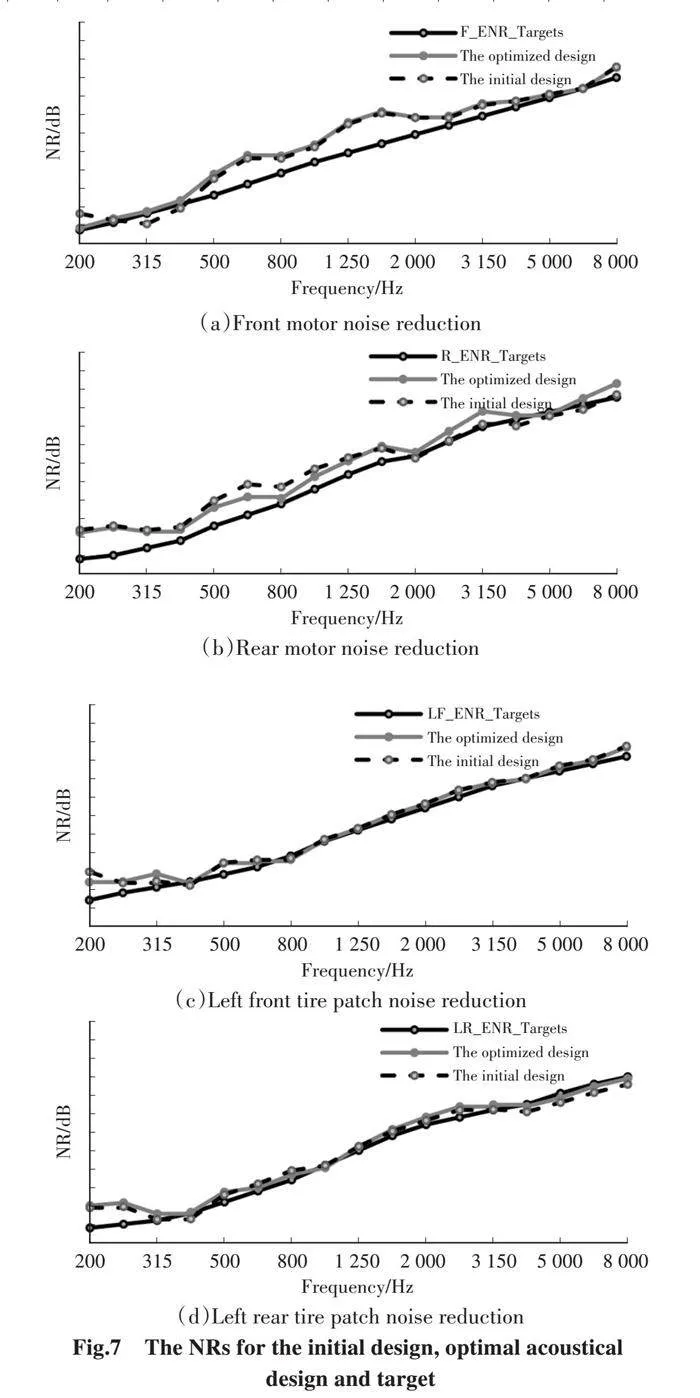
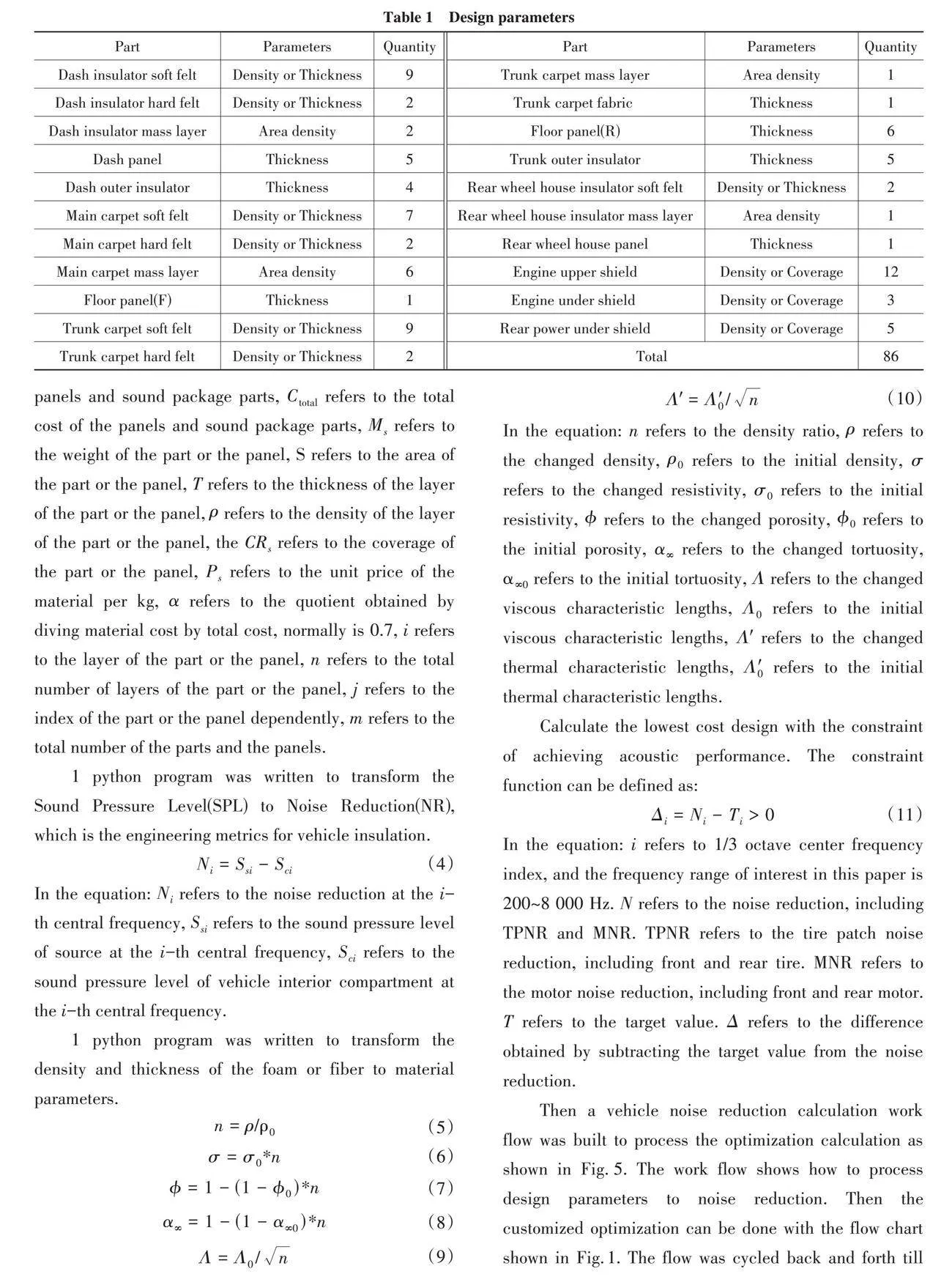
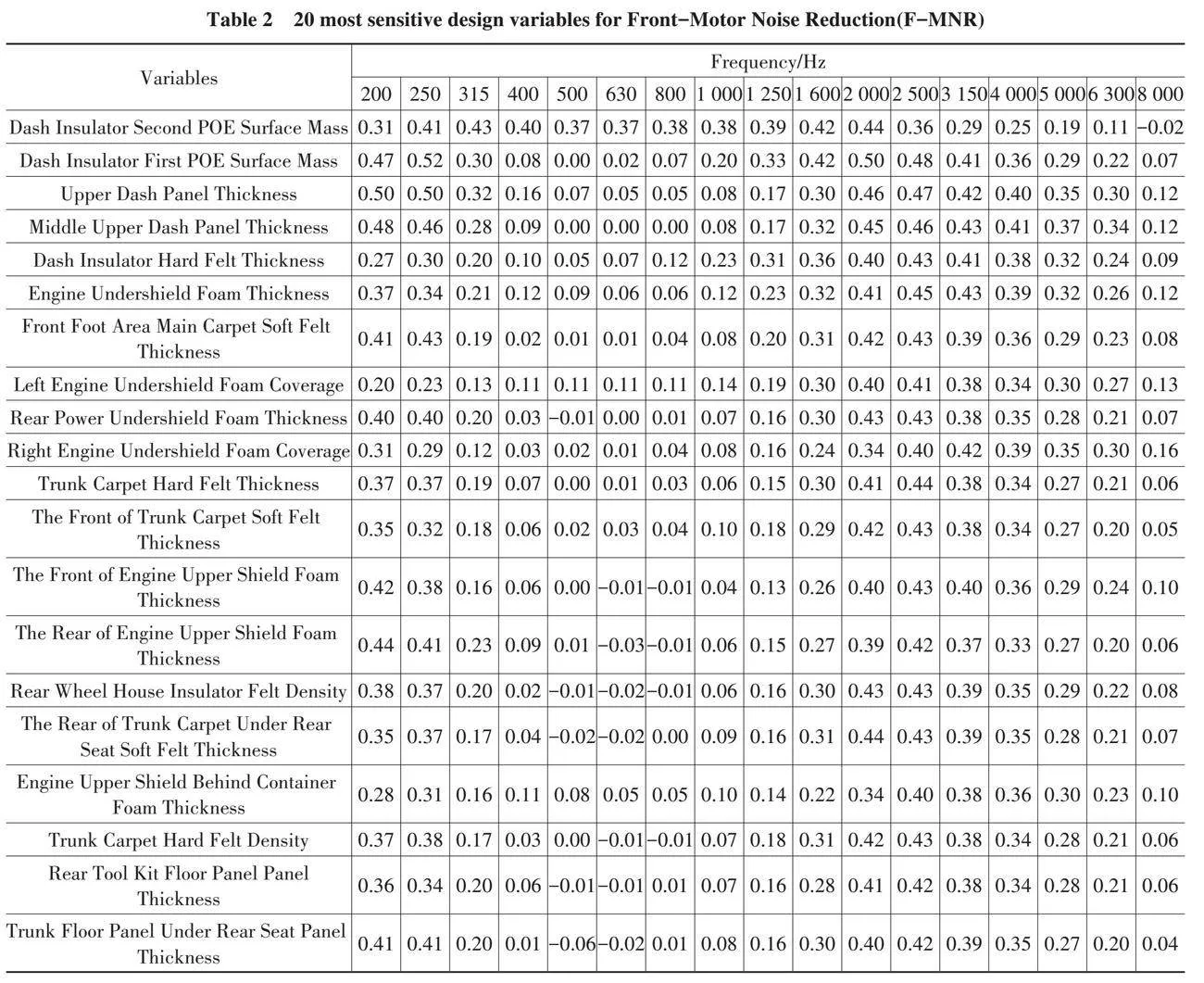
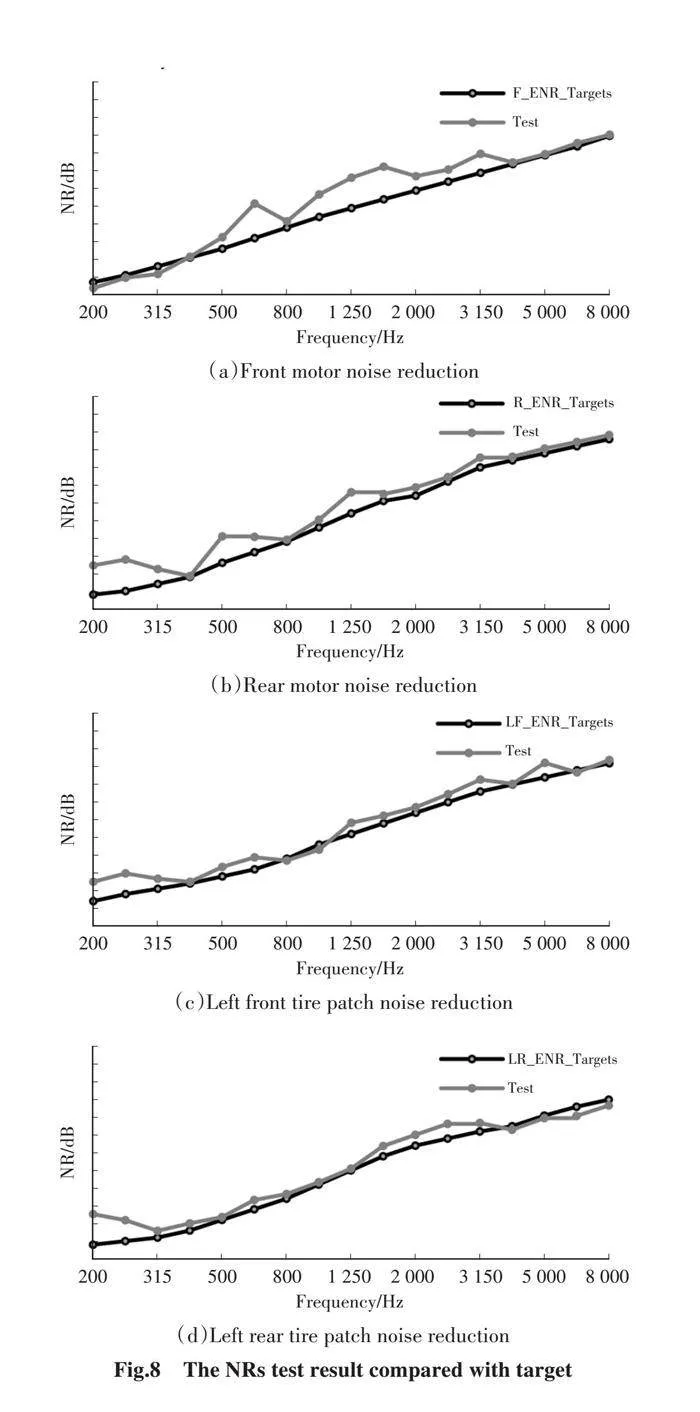


Customized Optimization for Vehicle Acoustic Statistical Energy Analysis
Huang Yi1,2,, Feng Qiuhan1,2,, Liu Jingqi1,2,, Li Xueliang1,2,, Liu Lin1,2, Yang Shaobo1,2
(1. Chongqing Changan Automobile Co., Ltd, Chongqing 400023;2. Chongqing Key Laboratory of Vehicle Intelligent Simulation, Chongqing 400000)
【Abstract】 Statistical Energy Analysis (SEA) is one of the conventional tools for predicting vehicle high-frequency acoustic responses. This study proposes a new method that can provide customized optimization solutions to meet NVH targets based on the specific needs of different project teams during the initial project stages. This approach innovatively integrates dynamic optimization, Radial Basis Function(RBF), and Fuzzy Design Variables Genetic Algorithm(FDVGA) into the optimization process of Statistical Energy Analysis(SEA), and also takes vehicle sheet metal into account in the optimization of sound packages. In the implementation process, a correlation model is established through Python scripts to link material density with acoustic parameters, weight, and cost. By combining Optimus and VaOne software, an optimization design workflow is constructed and the optimization design process is successfully executed. Under various constraints related to acoustic performance, weight and cost, a globally optimal design is achieved. This technology has been effectively applied in the field of battery electric vehicle(BEV).
Key words: Statistical Energy Analysis(SEA), Dynamic optimization, Radial Basis Function(RBF), Vehicle sheet metal, Sound package, Battery Electric Vehicle(BEV)
【欢迎引用】 黄义, 冯秋翰, 刘经奇, 等. 整车声学统计能量分析定制优化[J]. 汽车文摘,2024(XX): X-XX.
【Cite this paper】 HUANG Y, FENG Q H, LIU J Q, et al. Customized Optimization for Vehicle Acoustic Statistical Energy Analysis[J]. Automotive Digest (Chinese), 2024(XX): X-XX.
【摘要】统计能量分析(SEA)是预测整车高频声学响应的常规工具之一。为了在项目初期阶段依据不同项目组的具体需求,提供满足NVH目标的定制优化方案,提出了一种创新性方法,结合了动态优化、径向基函数(RBF)以及基于模糊决策变量的遗传算法(FDVGA)进行SEA优化,并将车身钣金纳入声学包优化的考虑范围。在实施过程中,利用Python脚本建立了材料密度与声学参数、质量及成本之间的关联模型。通过整合Optimus与VaOne软件,构建了优化设计工作流,并成功执行了优化设计流程,可以在不同的声学性能、质量及成本约束条件下,实现了全局最优设计。该技术已在电动汽车研发领域得到有效应用。
关键词:统计能量分析;动态优化;径向基函数;车身钣金;声学包;电动汽车
中图分类号:U461.4 文献标志码:A DOI: 10.19822/j.cnki.1671-6329.20240211
0 Introduction
In the concept design stage of a vehicle program, acoustical targets are defined according to performance requirements. This process is typically conducted using primarily benchmark information regarding the position of the vehicle within its market segment. A sound package “Bill of Material” is then created and packaging spaces are reserved in the design based on experience and competitive offering. Statistical Energy Analysis(SEA) methods are well developed within the automotive industry and have been shown to be effective for vehicle sound package design[1-3]. Optimization of sound package can be studied and conducted with this tool. Pan from Rieter Automotive has studied the sound package optimal design with respect to weight, cost and acoustical performance by Genetic Algorithms (GA) in 2003[4]. Wentzel from Roush Industries has developed an interactive approach to the design of a balanced vehicle sound package in 2007[5]. Lee from Seoul National University of Korea and Thomas from Melbourne Business School studied the key sound package part-dash insulator and floor carpet optimization design[6-7]. These approaches have been successful in achieving balance vehicle sound packages. However, there are several practical limitations in practice.
Firstly, the frequency ranges of interest for vehicle acoustic performance spans from 200 Hz to 8 000 Hz, which has 17 central frequency points under 4 conditions, including front and rear tire patch noise reduction, front and rear motor noise reduction. The noise reduction performance at each of central frequency needs to be achieved. This represent a typical multi-targets-conditions optimization. The GA used by Pan isn’t suitable to this comprehensive solution since the optimal search in the design space will be a huge work. Therefore, each central frequency performance was simplified to a sum of weighted values[4]. Taguchi analysis used by Thomas and the part contribution analysis used by Lee were sensitivity analysis other than optimization searches[6-7].
Secondly, a full vehicle noise reduction performance can be cascaded to several local sound insulation systems like dash area, floor area, etc. The local sound insulation system includes not only sound package parts but body sheet metal. It isn’t a real optimal solution if only sound package parts considered because both of them are the key factors for sound insulation. Besides that, different locations for one part should have different designs to achieve the leanest design according to the actual vehicle sound field. Only sound package parts as a whole were discussed in the study of Pan Jian and Richard[4-5]. Moreover, dash insulator and floor carpet were discussed in the study of Lee and Thomas[6-7].
Thirdly, sound package part is normally made of heavy layer plus foam or fiber decoupler. Surface density is the key design variable of the mass layer. Volume density and thickness are the key design variables of the foam or fiber. The material Biot parameters like porosity and flow resistance will be different when the material density and thickness are changed[8-10]. This issue was never clarified in all the referenced literature. The relationship between material Biot parameters and design variables should be considered in the process of the optimization.
In this paper, the Radial Basis Function(RBF) method[11] is introduced for the agent model establishment. Dynamic optimization and Fuzzy Design Variables Genetic Algorithm (FDVGA) are introduced as the optimization tools. FDVGA is developed by Yang and Chen[12-13] and is designed for multi-targets-condition optimization. A battery electric vehicle(BEV) SEA model is created to the study. Both sound package parts and related sheet metals are considered for the optimization. The relationship between volume density and thickness of the foam or fiber material and Biot parameters is established with Python programs. A total of 86 body sheet metals and sound package design variables for a new BEV program are optimized regarding program team need.
1 Dynamic Optimization and RBF
One of major features of full vehicle noise reduction performance is “the barrel effect”, which means it mainly depends on the weakest local sound insulation systems. Partial parameters in the weakest area has similar effect to acoustic performance. Therefore, in terms of mathematics, there are numerous local optimal solutions of full vehicle noise reduction performance optimization to achieve lowest possible mass or cost.
Most optimization processes include the following 3 steps: (1)Conducting experiments using the designing of experiments(DOE) method to acquiring uniform sample data. (2)Training an approximate surrogate model based on the sample data. (3)Performing optimization with a genetic algorithm and the trained surrogate model to obtain the optimal design. However, this approach has been found to be inadequate for this scene owing to low precision surrogate model during trials. As shown in Fig.1, this paper introduces a dynamic optimization process, which involves one or more additional experiments around potentially optimal design domain that would be conducted following the regular optimization process, if the last optimization fails to meet the optimization goal by the results. New data for training would be composed by these additional sample data and original sample data. This process would be continued until the optimization goal is achieved. These additional experiments would effectively enhance the precision in most concerned area which includes the optimal solution identified by the algorithm.
Further, the RBF algorithm is well known for its ability to approximate to local zone, but its precision strongly depends on its numerous parameters. Some researchers used genetic algorithm to obtain a better set of parameters[14], however it requires a lot of data and training time. A custom developed Radial Basis Function(RBF) surrogate model by back propagation[15] has been investigated. Considering model would been trained repeatedly, following measures as Fig.2 shown has been taken to improve training efficiency: (1)Gain the linear coefficient w by pseudo-inverse matrix of the product of middle layer matrix and real y to reduce the training computational complexity, and accelerate the training and improve the computational accuracy. (2)Limit the maximum number of iteration steps from traditional large order of magnitude to less than 100. (3)Increase learning rate to obtain optimal possible parameters in few steps, owing to step 1, a large learning rate would not cause divergence. The custom developed RBF algorithm could juggle efficiency and local approximation precision.
2 SEA Model and Optimization Flow Process Created
A four-door sedan EV SEA model as shown in Fig.3 was created. The model was built based on a validated previous similar project model and guaranteed with good precise in order to achieve the precise optimization results. The parts to be optimized are shown in Fig.4. A total of 86 design parameters undergoing optimization is listed in Table.1.
1 python program was written to make density, thickness, coverage rate, related to weight and cost.
[Ms=i=1n(S×Ti×ρi)] (1)
[Mtotal=j=1m(CRsj×Msj)] (2)
[Ctotal=j=1m(Msj×Psj÷α)] (3)
In the equation: [Mtotal] refers to the total weight of the panels and sound package parts, [Ctotal] refers to the total cost of the panels and sound package parts, [Ms] refers to the weight of the part or the panel, S refers to the area of the part or the panel, T refers to the thickness of the layer of the part or the panel, [ρ] refers to the density of the layer of the part or the panel, the [CRs] refers to the coverage of the part or the panel, [Ps] refers to the unit price of the material per kg, [α] refers to the quotient obtained by diving material cost by total cost, normally is 0.7, i refers to the layer of the part or the panel, n refers to the total number of layers of the part or the panel, j refers to the index of the part or the panel dependently, m refers to the total number of the parts and the panels.
1 python program was written to transform the Sound Pressure Level(SPL) to Noise Reduction(NR), which is the engineering metrics for vehicle insulation.
[Ni=Ssi-Sci] (4)
In the equation: [Ni] refers to the noise reduction at the i-th central frequency, [Ssi] refers to the sound pressure level of source at the i-th central frequency, [Sci] refers to the sound pressure level of vehicle interior compartment at the i-th central frequency.
1 python program was written to transform the density and thickness of the foam or fiber to material parameters.
[n=ρ/ρ0] (5)
[σ=σ0*n] (6)
[ϕ=1-1-ϕ0*n] (7)
[α∞=1-1-α∞0*n] (8)
[Λ=Λ0/n] (9)
[Λ'=Λ'0/n] (10)
In the equation: [n] refers to the density ratio, [ρ] refers to the changed density, [ρ0] refers to the initial density, [σ] refers to the changed resistivity, [σ0] refers to the initial resistivity, [ϕ] refers to the changed porosity, [ϕ0] refers to the initial porosity, [α∞] refers to the changed tortuosity, [α∞0] refers to the initial tortuosity, [Λ] refers to the changed viscous characteristic lengths, [Λ0] refers to the initial viscous characteristic lengths, [Λ'] refers to the changed thermal characteristic lengths, [Λ'0] refers to the initial thermal characteristic lengths.
Calculate the lowest cost design with the constraint of achieving acoustic performance. The constraint function can be defined as:
[∆i=Ni-Ti>0] (11)
In the equation: i refers to 1/3 octave center frequency index, and the frequency range of interest in this paper is 200~8 000 Hz. N refers to the noise reduction, including TPNR and MNR. TPNR refers to the tire patch noise reduction, including front and rear tire. MNR refers to the motor noise reduction, including front and rear motor. T refers to the target value. ∆ refers to the difference obtained by subtracting the target value from the noise reduction.
Then a vehicle noise reduction calculation work flow was built to process the optimization calculation as shown in Fig.5. The work flow shows how to process design parameters to noise reduction. Then the customized optimization can be done with the flow chart shown in Fig.1. The flow was cycled back and forth till the global optimized parameters were found.
Customized optimizations from program team were needed as follows: The primary objective was to achieve the lowest possible total cost . However, it was essential that these optimizations were carricd out without compromising the NR performance.
3 Result and Discussion
In this problem, the cost of the initial sound package and panel design is $318. Acoustical performance for the initial design and acoustical targets were analyzed as shown in Fig.6. A minimum total cost was calculated with the constraint of acoustical targets achievement.
An agent model was established with RBF method. Optimization was carried out via FDVGA with a population size of 860 and terminated at the 200th generation. The optimization took just under 60 h and involved 12 040 000 function evaluations.
Table 2~5 list the results of the top 20 most sensitive design variables under 4 different conditions, respectively. It is important to note that Design Sensitivity Analysis(DSA) results may be either positive or negative. The positive DSA result indicates an increase in noise reduction at driver’s ear location, while the negative result indicates a decrease in noise reduction at the location.
To increase F-MNR, the top 5 most efficient ways are: to increase dash insulator second PolyOlefin Elastomer(POE) surface mass, to increase dash insulator first POE surface mass, to increase upper dash panel thickness, to increase middle upper dash panel thickness, and to increase dash insulator hard felt thickness.
To enhance R-MNR, the 5 most effective methods are as follows: (1)To increase the rear power under shield foam thickness.(2)To increase rear wheel house panel thickness.(3)To increase rear wheel house insulator felt thickness.(4)To increase trunk carpet hard felt thickness. (5)To increase lower tool kit carpet soft felt thickness.
To increase LF-TPNR, the 5 most efficient ways are as follows: (1)To increase dash insulator second POE surface mass. (2)To increase dash insulator hard felt thickness. (3)To increase dash insulator first POE surface mass. (4)To increase lower dash insulator soft felt thickness. (5)To increase upper dash panel thickness.
To increase LR-TPNR, the 5 most efficient ways are as follows: (1)To increase rear wheel house insulator felt thickness. (2)To increase rear wheel house panel thickness. (3)To increase rear power under shield foam thickness. (4)To increase trunk carpet hard felt thickness. (5)To increase lower tool kit carpet soft felt thickness.
Fig.7 compares the NRs for the initial design, optimal acoustical design and target. The optimal solution is $24.6 lower than the initial design and well within the specified acoustical constraints.
The SEA model analysis indicates that: (1)The front wall system is the primary path of front sound insulation. The optimization of the dash panel and the thicker dash insulator soft felt is aimed at achieving the best cost performance. (2)Given the integrated battery under the cabin, the front floor system has a good soundproofing performance. A thin front floor panel with only the fabric layer retained for the main carpet is sufficient. (3)To maximize noise reduction, sound absorbing materials are added to the motor compartment, as proximity to the noise source enhances absorption efficiency. (4)The rear wheelhouse insulator is the main part of the low frequency noise insulation in the rear cabin. A thin rear wheelhouse panel and a redesign the rear wheelhouse insulator. (5)The inner trim cover is the main part of the high frequency noise insulation in the rear cabin. Change the material of the inner trim cover to plastic and sound-absorbing cotton is added locally. (6)Due to the presence of the trunk baffle, the rear floor system has good sound insulation. Optimize the rear floor panel to be thinner and retain only soft felt for the rear carpet.
4 Test Results
Optimization parameters were applied to the analyzed vehicle. The test result of the vehicle compared with the target is shown in Fig.8.
The test results show that all the NR targets were achieved as CAE predicted with the optimized design. The customized optimization was applied in the program successfully.
5 Conclusions
(1)The optimized process, which takes into account both the body panel and sound package components, achieves superior space utilization compared to focusing solely on the sound package parts.
(2)The relationship between material density and thickness with material simulation parameters is very important for the sound package optimization. The simulation was in-precise if they were considered independently. This can be resolved properly in this paper.
(3)The RBF and FDVGA method are very suitable for the multi-targets and multi-conditions optimization. According to the optimal result, the acoustical performance with the final optimal panel and sound package just achieved the target, which was called “just OK” design. That is valuable for the automobile industry, especially for X-EV vehicles.
(4)The optimal space will be further enlarged with innovative material parameter design. The optimization considering innovative materials will be the next necessary technical study.
Reference
[1] 邓江华, 宋俊, 李灿, 等. 乘用车声学包设计开发与优化技术研究[J]. 声学技术, 2015, 34(4): 353-357.
[2] LYON R H, DEJONG R G, HECKL M. Theory and Application of Statistical Energy Analysis, Second Edition[J]. Journal of the Acoustical Society of America, 1998, 98(6): 3021.
[3] CHARPENTIER A, BLANCHET D , FUKUI K. Full Vehicle SEA Model Uses Detailed Sound Package Definition to Predict Driver’s Headspace Acoustic Response[C]//INTER-NOISE and NOISE-CON Congress and Conference Proceedings, 2004.
[4] PAN J, SEMENIUK B P, AHLQUIST J, et al. Optimal Sound Package Design Using Statistical Energy Analysis[J]. SEA Technical Paper, 2003(1): 1544.
[5] WENTZEL R E, AUBERT A. An Interactive Approach to the Design of An Acoustically Balanced Vehicle Sound Package[J]. SEA Technical Paper, 2007(1): 2314.
[6] LEE H R, KIM H Y, JEON J H, et al. Application of Global Sensitivity Analysis to Statistical Energy Analysis: Vehicle Model Development and Transmission Path Contribution[J]. Applied Acoustics, 2019, 146(3): 368-389.
[7] THOMAS K J, WANG X, DOLLA E, et al. Simulation(SEA) Based Acoustic Optimization of Vehicle Carpet Systems[C]//15th International Congress on Sound and Vibration, 2008(1): 2752-2759.
[8] CASTAGNEDE B, AKNINE A, BROUARD B. Effects of Compression on the Sound Absorption of Fibrous Materials[J]. Applied Acoustics, 2000, 61(2): 173-182.
[9] BOLTON J S , KANG Y J. Elastic Porous Materials for Sound Absorption and Transmission Control[J]. SAE Technical Papers, 1997: 971878.
[10] NARANG P P. Material Parameter Selection in Polyester Fibre Insulation for Sound Transmission And Absorption[J]. Applied Acoustics, 1995, 45(4): 335-358.
[11] POWELL M J D. Radial Basis Functions for Multivariable Interpolation: A Review[M]. In algorithm for Approximation(143-167). Oxford: Clarendon Press, 1987.
[12] YANG X, ZOU J, YANG S X, et al. A Fuzzy Decision Variables Framework for Large-Scale Multiobjective Optimization[J]. IEEE Transactions on Evolutionary Computation, 2023, 27(3): 445-459.
[13] 陈爱国, 周世俊. 基于模糊逻辑的多目标优化问题遗传算法求解探讨[J]. 河南科学, 2006, 24(4): 482-484.
[14] 薛小杰, 黄强, 惠泱河, 等. 基于径向基函数神经网络与改进遗传算法的黄河流域需水预测[J]. 水土保持学报, 2002, 16(3): 83-85.
[15] RUMELHART D E, HINTON G E, WILLIAMS R J. Learning Representations by Back Propagating Errors[J]. Nature, 1986, 323(6088): 533-536.
(责任编辑 梵玲)

